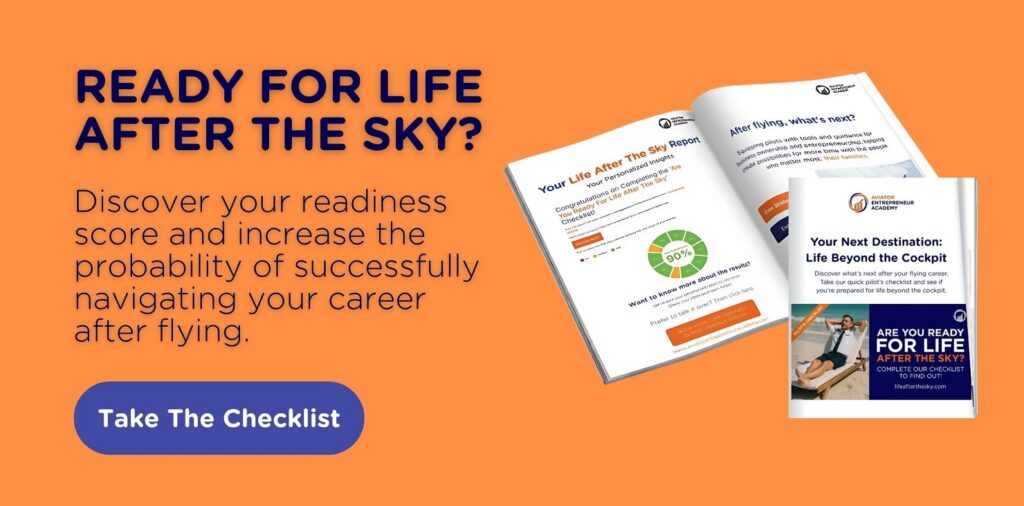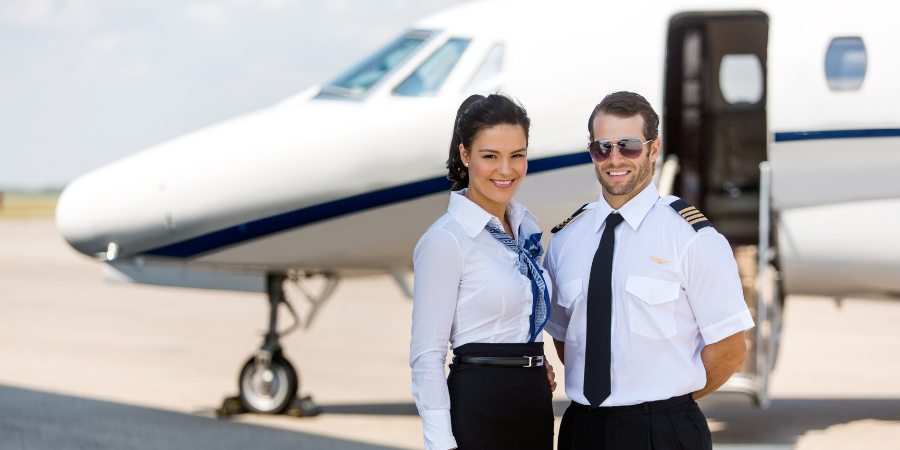As pilots, safety is second nature. We’re trained to follow checklists, trust our instruments, and minimize risk at all costs. But that same instinct, what keeps us alive in the sky can quietly sabotage us on the ground.
For many pilots, sticking to the flight path feels responsible. Logical. Safe.
But here’s the truth only a few want to admit: the longer we wait to look beyond flying, the harder the landing becomes when change eventually hits.
Key Takeaways
- Ground roles aren’t always the safe backup: Becoming an instructor or taking a desk job may sound secure, but often means less pay, irregular hours, and little creative fulfillment.
- Waiting until after flying is risky: Starting something new only after leaving the cockpit usually means we’re building under pressure, with lower energy and fewer resources.
- Early entrepreneurship creates security: Launching a side business while still flying reduces career risk and creates a sense of freedom, identity, and financial stability.
- AEA scorecard helps you get unstuck fast: This scorecard shows exactly where you stand and what steps you need to take next, in under 3 minutes.

The Myths That Keep Pilots Grounded
Before we talk about what we should be doing, we must address what’s quietly holding most pilots back: a belief system that feels safe but isn’t.
Over the years, I’ve spoken with dozens of pilots. Some were nearing retirement, and some were just hitting command. Regardless of age or experience, the same three myths come up every time we talk.
Let’s break them down one by one.
Myth 1: “I’ll Stay in Aviation Until I Retire”
This is perhaps the most common belief among career pilots, and one of the riskiest ones as well. The idea of flying comfortably until 65, cashing in our pension, and then exiting on our own terms feels like the reward for years of sacrifice.
But here’s the problem: very few pilots actually get to write their own ending.
Many pilots retire early, or get grounded due to medical disqualifications, mergers, downsizing, or simply burnout, even though the official retirement is later.
During COVID-19, Statista published a report revealing that over 80,000 airline workers, including thousands of pilots, were facing furloughs. This shows how uncertain conditions can change the trajectory of a career in mere days.
For many, this event was also a wake-up call that the system they trusted had no backup plan for them. Without a Plan B by the time we’re 45, the cockpit starts to feel like a trap, not a career. The worst part is that the longer we wait, the harder it will be to build something.
Myth 2: “I’ll Just Become an Instructor or Take a Ground Job”
When pilots think about life after flying, the first fallback is usually something familiar: becoming a flight instructor, a simulator trainer, a chief pilot, or taking up a role in safety or operations. For pilots nearing retirement, this feels like the logical next step.
However, the issue is that these roles rarely offer the freedom, income, or long-term security that pilots actually look for.
Let’s pause and talk about money first. Reports show that while major airline captains can earn upwards of $250,000+, many ground roles like instructor or training captain often pay 40% to 60% less.
The worst part is that the hours may not improve much, as ground jobs such as simulator schedules often run overnight. Many pilots step into these roles thinking they’ll finally have more time for family, only to find themselves tied to yet another unpredictable routine.
Moreover, ground roles erode a pilot’s sense of identity. We go from commanding aircraft to managing paperwork or teaching students who may not appreciate our discipline or experience.
So, even though it might sound like a softer landing, it’s not enough to get us more time or help we feel empowered.
Myth 3: “I’ll Wait Until I Stop Flying to Start Something”
Some of the pilots I talked to believe they’ll build something meaningful after they’re done with flying, as they’ll have “more time” then.
But the reality is that if we wait until we stop flying, it is often the worst time to start something new. You might be wondering why.
By then, we’ll have lower energy, our motivation will be reactive rather than creative, and the pressure will be far greater without a job in hand. At that time, we’ll be building something out of necessity rather than from a place of vision.
This is not us leaving our job immediately and jumping into something full-time. It takes time to plan and build parallel options while we’re still flying. That way, if one day we decide to move on or the aviation shifts, we’ll have something to lean on to.
The Smarter Solution: Why Early Entrepreneurship Works
If flying until retirement is uncertain, adjacent jobs offer limited freedom, and waiting until we stop flying feels too late…
What’s the alternative?
Early entrepreneurship. Not the kind that forces us to quit flying, but the one that grows beside our career.
It’s like a backup generator. We may never need it urgently, but it could save everything when the power goes out. Here’s why this works so well for pilots:
1. Lowers Career Risk Over time
Entrepreneurship gives us a second stream of income and more importantly, a second identity. We’re no longer 100% dependent on our license, our airline, or our health. Even if flying slows down, our momentum doesn’t.
Pilots who start entrepreneurship early often report lower stress and high confidence. It’s because they know their future isn’t tied to a single employer or aircraft type.
2. Can Start Small, Without Leaving the Cockpit
We don’t need to quit our job or take massive risks. Many successful Aviator-Entrepreneurs begin with 1 to 2 hours a week. They test ideas. Learn skills. Build frameworks. Over time, what begins as a side project becomes a serious option, not just a distant dream.
With 50% of businesses failing within the first five years, the ones that were started as side ventures had a 33% higher survival rate. These were the ones that emerged out of passion, not out of desperation.
3. Aligns With the Life We Actually Want
Most pilots don’t want to be stuck in meetings, chasing clients, or running a 9–5 business. They want something flexible, meaningful, and scalable.
Something that lets them spend more time with family. Control their calendar. Reconnect with purpose. And entrepreneurship can be that vehicle, if it’s designed right.
Invitation to join our FREE Strategy Session
Most pilots are one honest conversation away from clarity. This is that conversation.
Complete our “Life After the Sky” checklist, then join me for a FREE 15-minute “Strategy Session” via Zoom.
This session has been created for pilots who want to take ownership of what comes next.
Those who want action, not just to talk about it.
In just 15 minutes, we’ll:
- Review your checklist results
- Identify the one obstacle holding back your reinvention
Translate your checklist results into a clear starting point
Start your pre-flight assessment for the next chapter of your journey by Booking your free strategy session here!



